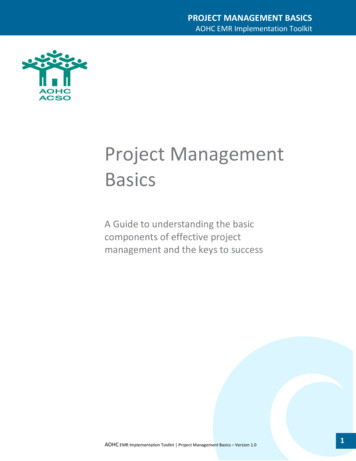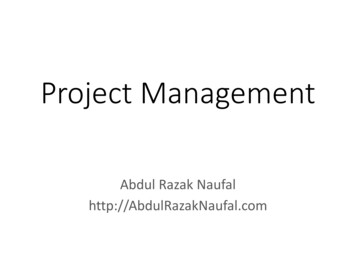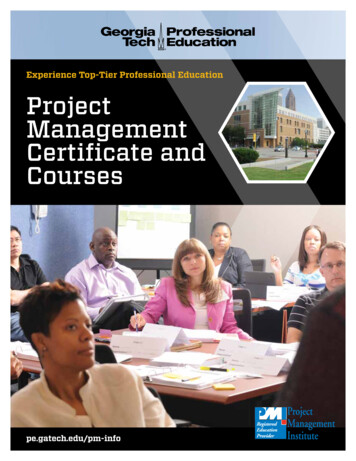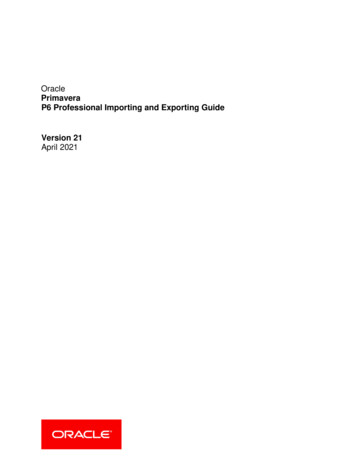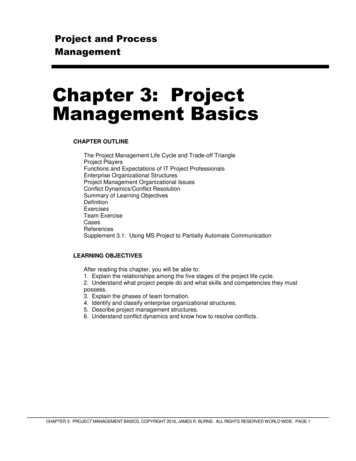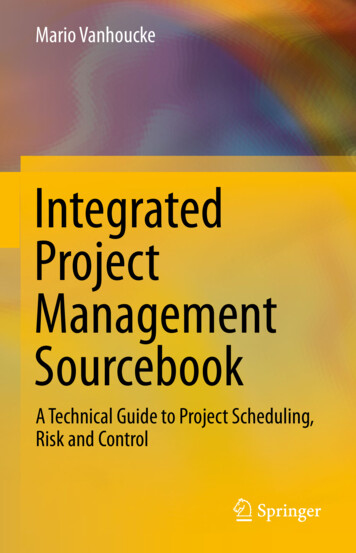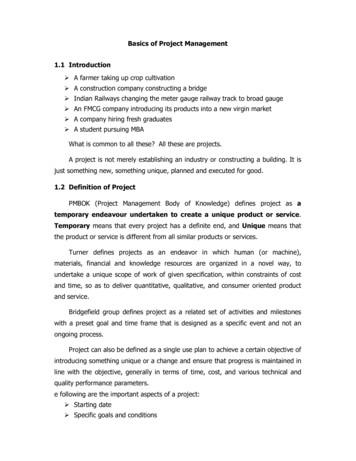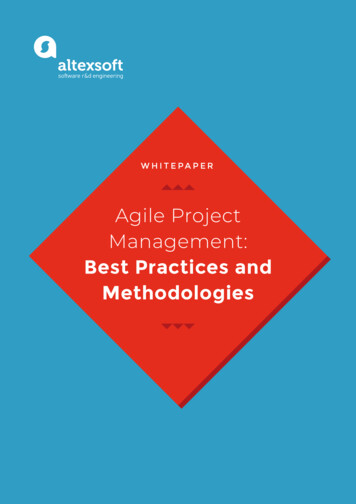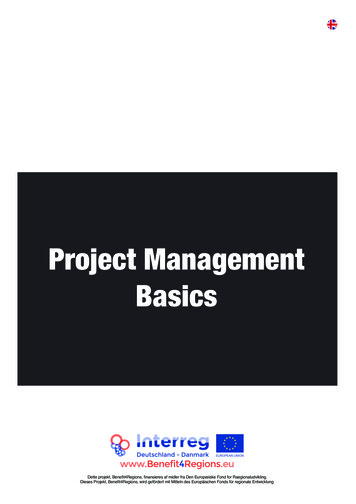
Transcription
Project ManagementBasicsDette projekt, Benefit4Regions, finansieres af midler fra Den Europæiske Fond for Raegionaludvikling.Dieses Projekt, Benefit4Regions, wird gefördert mit Mitteln des Europäischen Fonds für regionale Entwicklung.
Disposition1. Introduction into project management2. Framework conditions of project management3. Hard skills for project management4. Soft skills for project management5. Roles and commitment in projects6. ConclusionHauke Klünder & Prof. Dr. Uwe RammertKreis Plön & Landesamt für Landwirtschaft,Umwelt und ländliche Räume des Landes Schleswig Holstein (LLUR)Benefit4RegionsMarch 2019www.benefit4regions.euwww.copedia.eu1
1. Introduction into project managementThis paper gives a general introduction into basics related to project management. The paper doesnot follow a specific project management concept or direction. It is more or less a general and shortoverview over different factors like§ framework conditions§ hard skills§ soft skills§ roles and commitmentwe identified as a useful theoretical entry to manage multilateral projects as good as possible. Thesecan be useful if you plan a project or want to reflect your own knowledge towards projectmanagement.First of all, what is a project? - A project is a temporary interaction with a specific scope and specificresources as well as a defined beginning and ending. In general projects are unique (new and risky)as well as no routine interactions. Projects deal with context related complexities which always differand usually require a separate project management approach.What is the task of project management? - The general task or goal of project management is toprepare, conduct and implement successful projects which help to solve challenges - no matter towhat kind of project. Projects become more and more important in a more and more complex world.In the case of rural development this complexity leads to many new topics and projects that should befostered by public organisations. So projects will be an inherent part of development processes in thefuture.This is nothing new! - That’s right, but Why do so many projects not succeed? - On one hand, there is no clear answer to that questionbecause projects are always different. On the other hand, successful projects obviously find betterways to adapt their project management to new or different circumstances, different stakeholders andat least different cultures to avoid too many mistakes. Finally, classical linear (e.g. waterfall) projectmanagement can not be the future solution to succeed.That means, there is no general cookbook for successful projects?!But useful basics as an orientation!Let us start with project planning as a flexible cycle for project management!Project planning is more or less a project cycle which helps to plan (f.e. goals/targets timeline,resources,), structure (f.e. milestones, task management) and monitor/evaluate projects from ageneral point of view. The figure on the next page is one of many good conceptual samples which isdeveloped in the context of projects from the framwework of environmental management (housing,industrial installations, nature reserves etc.)2
It starts with the analysis of information by identifying project goals and doing an inventory of naturalressources, the recent situation, options of activities, and maybe even the skills and abilities of theteam members (see chapter 2). The next step is participation of collaborators (if necessary) which isimportant to create a goal concept, an action plan and make it transparent. Afterwards these centralaspects of a plan need to be adapted to the planning level and transferred into a more concreteimplementation structure of the plan. Finally the monitoring/evaluation of success during or after theimplementation of a project is elementary to proof or adapt the goal concept of a project. The steps ofthe process can also be found in some more detail in the organisation of the “Case Study MethodTool” which has been used as a basis of analysis during the Benefit4Regions project.This procedure/these steps on the one hand will lead towards a structured and understandableproject management plan which fits for all stakeholders and can be change in the specific context of aproject. On the other hand the plan as well as the scope of the project needs to be adapted todifferent circumstances and stakeholders. Especially in more complex projects different types ofcompetence should be regarded:§ Analysis of information related to context/situation§ Adaptability of social circumstances§ Personal-specific skills§ Method-specific skillsThe degree of complexity of those project management plans are related to those types ofcompetences and need to be adapted for each project to design an efficient and lean process.3
2. Framework conditions of project managementWe understand “the magic triangle of project management” as the classical and timeless frameworkconditions of project management. It covers the three dimensions of “cost/resources – time/schedule– scope/activity” as well as the “project quality/stakeholder satisfaction” as a forth and parentdimension.Project management is always and in general a challenging task where these three dimensions ofcost/resources, time/schedule and scope/activities need to be balanced to achieve a good projectquality related to the project goals. No matter if you realize an infrastructure like a house, work ondevelopment strategies/concepts or implement a new product.Those project managers who keep these three dimensions in mind are one step closer to take goodand target-orientated decisions in a project. Nearly every decision has an impact on the dimensions:Cost/ResourcesHow much budget do we have in relation to implementation cost?How many collaborators do we need related to the targets?Time/ScheduleHow much time do we have to conduct the project?What do we do when we are out of the schedule?Scope/ActivitiesHow many project goals should we define?Which activities or steps fit to the project goals?Finally let us have an short look on the dependency of those three dimensions by an easy example of“building a house”:4
Cost/Resources vs. Time/ScheduleThere is a deadline to complete a house but it can not be implemented in time. The solution could beto let more handworker work on that house. This all works but has an impact on the budget. This isthe classical conflict between cost and time.Cost/Resources vs. Scope/ActivitiesSimilar challenge: Budget is nearly exhausted but the roof needs to be finished. So the quality of thematerial needs to be reduced to fit into the budget which does not satisfy the customer.Time/Schedule vs. Scope/ActivitiesThe customer planned to have eye catching elements on the frontage of the house. But the handworkneed more time as planned. So if they should finish the work in time, they need to reduce the quality.How is this related to stakeholder satisfaction? In general it is all about the satisfaction ofstakeholders who always have different demands and points of view related to these dimensions. Asa project manager it is not enough to manage those dimensions a good way. It is of importance tofulfill the expectations und requirements of all stakeholders. Therefor the main task for a projectleader is success by fulfilling these dimensions as well as getting acceptance of all stakeholders.3. Hard skills for project managementThe hard facts of project management deal with the question of “How do we structure andsuccessfully implement a project management plan?” related to the defined framework conditions.That is important to have a commitment with collaborators and get into interaction. It also means todivide the process of a project into different general phases and describe the purpose and the taskslike the project planning example in the introduction visualized as an example.There are many phase models that can be used to divide a project into different parts. According tothe variety of projects from simple to very complex projects four phases and one additional phasecould be regarded as a basics approach/inspiration. The table on the next page gives a generaltheoretical overview about the phases as well as the tasks which should be modified and adapted foreach project.In addition to the table, two different types of competences are import to make sure that a structure ofa project management plan is valid and transparent as well as accepted by all collaborators:§ Analysis of context/situation (f.e. strategies/concepts of collaborators, activities ofcollaborators, political system, administration system, Economic system, Tax system, socialsystem)§ Method-specific skills (f.e. formats for user participation, working structure/design, definition oftarget, task management, strategy building)Different types of tools can be used to support project management in these processes like§ Project development tools (e.g. Business model Canvas, , )§ Project structure tools (e.g. Gant Chart, Mind Map, asana, agantty )§ Schedule tools (e.g. MS Project, OpenWorkBench, groupware tools etc.)§ Information tools (e.g. project homepage, moodle, )§ Communication tools (e.g. telefon, e-mail, skype, slack, )§ Collaboration tools (e.g. realtimeboard, groupware tools, )Finally the different type of tools and the examples show the variety and the amount of options. Thisleads to the declaration that everything in project management is related to the project itself andneeds to be adapted.5
6
4. Soft skills for project managementThe soft skills for project management deal with the question: “How do we guide the projectmanagement process and its scope/activities with success?” related to the defined frameworkconditions and the different phases of a project and its complexity. That is important related to the factthat every project is different and always a learning process of avoiding pitfalls and mistakes. Guidingthese learning processes by soft skills means to create an efficient and lean process. This dependsmore or less on different types of competences which include:§§§Personal-specific/social skills (f.e. communication, moderation/mediation, empathy)Method-specific skills (f.e. formats for user participation, working structure/design, definition oftarget, task management, strategy building)Adaptability of social circumstances (f.e. values & norms of societies, mentalities, behaviours)Moreover in the case of learning to succeed the connection of Mindset – Skillset – Toolset is gettingmore and more important to achieve valuable and successful projects. This has something to do withthe way project manager guide a structured process and different tasks as well as activities that arearranged with all collaborators.The table shows an overview of this connection:MindsetMindset is the most critical part of projects because it influences the way of collaboration. Therefor themindsets of project leader as well as collaborators need a common base/commitment in the way ofthinking and acting. Otherwise there will be a lack of achieving common targets.Diversity management is an important approach to deal with different mindsets. A project leaderneeds to be a mindful communicator/facilitator who cares about the differences, gets access toeveryone to manage a common understanding and stays a neutral person.SkillsetSkillset is the most obvious part of projects because competences and skills are needed to ensure agood quality of outputs. It is a learning process which is up to the personal-specific skills of each7
collaborator. “Learning from each other” means to exchange knowledge which should be regarded asa central part in each project.Important skills are moderation/mediation, presentation, documentation and communication as well asbeing a good bridge builder and facilitator.ToolsetToolset is also a critical part of projects because the usage of methods and tools e.g. in the case ofparticipation is getting more and more important to facilitate knowledge as well as to co-design andimplement new ways of development. The more transparent methods are, the more easier it is tocollect new knowledge and to co-create value in multilateral projects and to enhance development.The toolset depends on the concrete project and should fit to the skills as well as to target groups andproject goals.Finally, all of this also depends on the adaptability of social circumstances. The more local as well asinternational a project is, the more differing those circumstances are and needs to be regarded as anorientation point for the level of outputs and solutions.8
5. Roles and commitment in projectsSuccessful projects find better ways to adapt their project management to new or differentcircumstances, different stakeholders and at least different cultures to avoid too many pitfalls andmistakes. This includes the mentioned hard and soft skills but with less importance the definition ofroles and the commitment of stakeholders. This is something which can partly be influenced byproject manager to succeed. But it is a mutual relationship which is more or less up to everystakeholder.“What do we need for a good commitment of all stakeholders?”The willing and openness of all stakeholders as well as their organizations is needed. Otherwise thereis always a lack which leads to more missunderstandings and conflicts. In the initiation phase of aproject the clarification of roles and the need for commitment must be coordinated and ensured by allcollaborators. The table on the next page gives some kind of “golden advices” related to the roles ofproject leader and stakeholder and their commitment in a project:9
6. Conclusion for multilateral projectsThe project management basics pointed out the most relevant conditions and facts for projectmanagement in short cuts. These should be seen as adaptable orientation points because every projectis an individual challenge and no universal cook book of project management can be used.According to this international as well as multilateral projects have the highest requirements on projectmanagement related to the project management plan as well as mindset, skillset and toolset. Thatmeans to make sure that the project management has the relevant abilities to master the own role aswell as building bridges to stakeholder needs, facilitate roles of stakeholders as well as the neededcommitments to conduct and communicate a successful project. Therefor different types ofmanagement are important like:§ Project planning management§ Knowledge management§ Diversity management§ Participation management§ Communication management§ Conflict managementRelated to public organizations and the growing complexity in the world, international and multilateralprojects are needed. Finding easy answer for all those complex challenges “next door” is more or lessimpossible. Thus public organizations will be forced in the future to identify new collaboration partnerswith similar challenges.Finally this framework document as well as the others will give a theoretical access for target groups tothose challenging international and multilateral projects. This will be completed by the applicationorientated “B4R-CODE – A SMARTER way for Comprehensive Development” with its general strategyand specific partial strategies. This approach builds up a cross section through all activities of theInterreg 5A project Benefit4Regions.10
1. Introduction into project management This paper gives a general introduction into basics related to project management. The paper does not follow a specific project management concept or direction. It is more or less a general and short overview over different factors like § framework conditions § hard skills § soft skills
